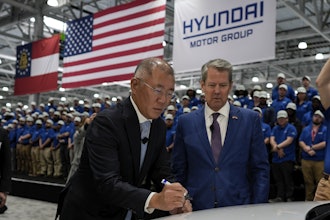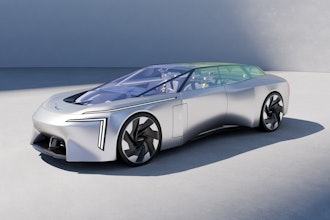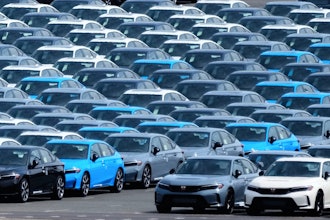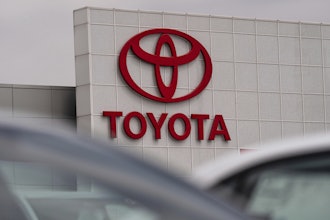With sporty styling and standard high-tech features, the Hyundai Veloster — the automaker's fourth new car that earns a fuel mileage rating of 40 miles per gallon on the highway — sure doesn't look like a fuel miser.
No wonder. Hyundai officials want the compact car to attract young drivers.
But the Veloster's eye-catching looks, innovative third side door, generous cargo space, 10-year/100,000-mile powertrain warranty, five years of complimentary roadside assistance and a five-year/60,000-mile vehicle warranty can appeal to value-conscious buyers of many ages.
So can the starting retail price of $18,060. This is for a model with six-speed manual transmission. A Veloster with automatic transmission has a starting manufacturer's suggested retail price, including destination charge, of $19,310.
In comparison, the competing 2012 Scion tC coupe, which is rated at 31 mpg on the highway, has a starting MSRP, including destination charge, of $19,305 with manual transmission and $20,305 with automatic transmission.
Another competitor in the sporty, affordable compact segment is the 2012 Honda CR-Z hatchback, which is rated at 39 mpg on the highway when fitted with a continuously variable transmission (CVT). But the CVT pushes the CR-Z starting retail price to $20,195; it's $19,545 with a manual transmission.
Both the tC and CR-Z come with vehicle warranties lasting three years/36,000 miles and powertrain warranties good for five years/60,000 miles.
As is typical with Hyundai vehicles, every Veloster has a good number of amenities.
Air conditioning, power windows and door locks, remote entry, iPod and USB auxiliary jacks, a 7-inch light-emitting diode display screen, steering wheel-mounted radio controls, cruise control and AM/FM/XM/CD/MP3 audio system are standard on every model.
Buyers get a complimentary period to use the XM satellite radio as well as Hyundai's new BlueLink telematics system which is being introduced in the Veloster first before other Hyundais. BlueLink is similar to OnStar in General Motors' vehicles with emergency crash notification, turn-by-turn directions to destinations and electronic notification to friends or family about your location.
Also not to be missed: Every Veloster is ready for use of Pandora Internet radio through a passenger's iPhone. Gracenote voice recognition and music cover art also are ready to work with an iPod.
The Veloster, which replaces the long-gone Hyundai Tiburon coupe, turned heads during the test drive.
But no one had a clue that the Veloster has an innovative third, front-hinged door on the passenger side that eased entry into the back seat. The door handle is hidden in the black back edge of the window. The only giveaway is the gap between pieces of sheet metal.
Without this door, anyone wanting to get into the back seat would have to do what they do in other two-door compacts: Push/fold front seats forward and contort around the front bucket seats.
The Veloster's fuel mileage is an obvious selling point. The 1.6-liter, double overhead cam, gasoline direct injection four cylinder meters the fuel to get that federal government fuel efficiency rating of 28/40 mpg with manual transmission.
The test car, which had a six-speed manual that shifted well, averaged a commendable 35 mpg in travel that was 65 percent in city traffic and 35 percent on the highway.
Velosters with the six-speed automatic transmission have a 29/38-mpg rating from the federal government.
The Veloster's 2,600-pound-plus weight, which is 400 pounds lighter than the Scion tC, helps make the car peppy. After all, the Veloster's output of 138 horsepower and 123 foot-pounds of torque at a high 4,850 rpm is mild compared with the tC's 180 horses and 173 foot-pounds of torque at 4,100 rpm.
Still, the test car exhibited a nice balance of fuel frugality and happy performance in real road situations. With manual gear selection, the car had decent zip to merge into city traffic, and highway travel was satisfactory.
Sport enthusiasts should wait until summer, when a 201-horsepower, turbocharged Veloster is due to arrive.
Less than 14 feet long, from bumper to bumper, the test Veloster maneuvered nimbly in traffic and in constrained parking lots. The turning circle is a tidy 34.2 feet, so U-turns are no fuss.
There is a firmness, almost a stiffness, in the ride, and passengers felt road bumps, big and minor. For example, the test car, with upgraded 18-inch tires, sent through to the passenger compartment vibrations and sounds of manhole covers in the roads. The front-wheel drive car rode solidly, however. The body didn't flex or shudder over bumps as Hyundai made good use of high-tensile steel in the car body.
Note the back seat has two sculpted seats with a small shelf and cupholders between them. There are only two seat belts back there, so the Veloster cannot seat five.
Unfortunately, back-seat riders sit with their heads under the large glass hatchback window, so heads can get hot in warm weather. At 5 feet 4, I sat snugly in back, with 31.7 inches of rear-seat legroom and 35.3 inches of headroom. Tall rear-seat passengers might need to duck their heads when the hatchback liftgate is being closed, because, depending on how they're seated, they may get hit on the head by the descending glass.
The test car had optional panorama roof, which gave an airy feel inside but it reduced front-seat headroom by 1.8 inches. Back-seat headroom is unaffected.
The hard cover over the 15.5-cubic-foot cargo area banged down noisily when the liftgate came down. Cargo space expands to a commendable 34.7 cubic feet when rear seatbacks are folded down.


















